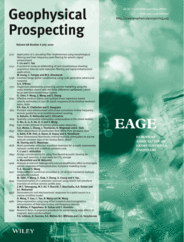-
oa Offset dependence of overburden time‐shifts from ultrasonic data
- Source: Geophysical Prospecting, Volume 68, Issue 6, Jun 2020, p. 1847 - 1863
-
- 12 Nov 2019
- 19 Apr 2020
- 21 May 2020
Abstract
Depletion or injection into a reservoir implies stress changes and strains in the reservoir and its surroundings. This may lead to measurable time‐shifts for seismic waves propagating in the subsurface. To better understand the offset dependence of time‐shifts in the overburden, we have systematically quantified the time‐shifts of three different overburden shales in controlled laboratory tests. These experiments may be viewed as an analogue to the time‐shifts recorded from seismic field surveys. For a range of different stress paths, defined as the ratio between the horizontal and the vertical stress changes, the changes of the P‐wave velocities in different directions were measured such that the offset dependence of time‐shifts for different stress paths could be studied. The time‐shifts are stress path dependent, which is particularly pronounced at large offsets. For all stress paths, the time‐shifts exhibit a linearly decreasing trend with increasing offset, that is, a negative offset gradient. At zero offset, for which the ray path is normal to the bedding, the time‐shifts are similar for all investigated stress paths. The isotropic stress path is associated with the smallest offset gradient of the time‐shifts. In contrast, the constant‐mean‐stress path shows the largest gradient with a flip in the polarity of the time‐shifts for the largest offsets. The separate contributions from the strain and velocity changes to the time‐shifts were also quantified. The time‐shifts for the isotropic stress path are dominated by the contribution from velocity changes at all offsets. In contrast, the strain contributes significantly to the time‐shifts at small offsets for the constant‐mean‐stress path. This shows that the offset dependence in pre‐stack seismic data may be a key to understand the changes of subsurface stresses, pore pressure and strain upon depletion or injection. To utilize this knowledge from laboratory experiments, calibrated rock physics models and correlations are needed to constrain the seismic time‐shifts and to obtain an adequately updated geological model reflecting the true anisotropic nature of the subsurface. This may have important implications for improved recovery and safety, particularly in mature fields.




